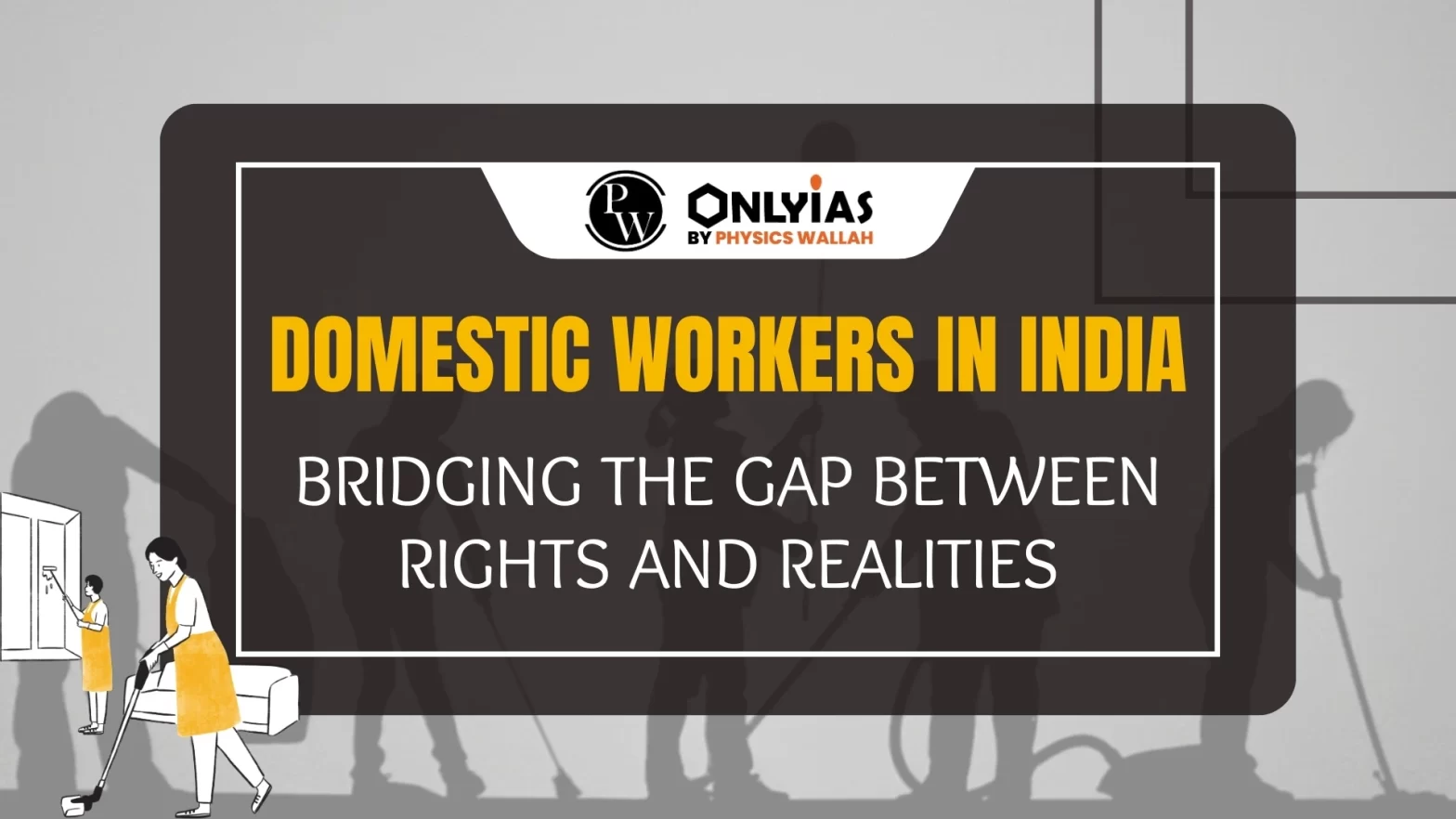Context: This article is based on an Editorial “14-year-old’s torture is wake-up call – we must treat our domestic help better” which was published in the Times of India. Recently, a 14-year-old girl working in Gurugram as a house help was rescued last week after five months of captivity at her employer’s house.
| Relevancy for Prelims: International Labour Organisation, Domestic Workers, National Policy for Domestic Workers, and Rashtriya Swasthya Bima Yojana (RSBY).
Relevancy for Mains: Domestic Workers in India- Challenges faced by them and Way Forward. |
Who are domestic workers as per the ILO?
- Part of Care Economy: Domestic workers are those workers who perform work in or for a private household or households. They provide direct and indirect care services, and as such are key members of the care economy.
- Types of Domestic Workers: A domestic worker may work on full-time or part-time basis.
- They may be employed by a single household or through or by a service provider.
- They may be residing in the household of the employer (live-in worker) or may be living in his or her own residence (live-out).
- Migrant Domestic Worker: A domestic worker that may be working in a country of which she/he is not a national.
- Higher Contribution by Females: Of the 75.6 million domestic workers worldwide, 76.2 percent are women, meaning that a quarter of domestic workers are men.
Domestic Workers in India: Statistics
| Description |
Value |
| Estimated number of domestic workers |
4.8 million |
| Number of female domestic workers |
2.9 million |
| Percentage of women’s total employment in domestic work |
3.5% |
| Rank of domestic workers among working categories |
3rd |
| Number of domestic workers according to National Domestic Workers’ Movement |
50 million+ |
| Percentage of domestic workers working in urban areas |
66% |
| Percentage increase in the number of domestic workers in the last decade |
75% |
Must Read: ILO Report On Occupational Safety And Health (OSH)
What are the faced challenges by domestic workers in India?
- Poor Working Conditions: Domestic workers in India are denied minimum wages and lack any social security cover. Many workers are exploited to work for long hours.
- Lack of Laws to Protect Rights: The domestic workers in India are not covered by any Act.
- The National Commission for Women had drafted the Domestic Workers (Registration, Social Security and Welfare) Bill in 2008-10. However, the Bill wasn’t passed.
- Issues in Implementation: Domestic work was added to the list of scheduled employment under the Minimum Wages Act, 1948, which coincided with the ILO convention 2011. However, the implementation remains poor and only 13 States/UTs have passed legislation requiring minimum wages for domestic employees.
- Insufficient Data: There is a lack of reliable data for the number of domestic workers in India. There is large variation as the number of workers varies from 4 millions to 50 millions.
- Informal Placement Agencies/Housekeeping Companies: The companies that provide domestic workers in urban areas are more focused on their own profits and care little about the rights of the workers. Lack of scrutiny of their functioning contributes to the exploitation of the workers.
- Neglect of Domestic Labour Rights: Legislation pertaining to workers such as the Industry Disputes Act, 1947, the Employee’s Provident Fund Act, 1952, and the Factories Act, 1948, do not recognise the labor performed by domestic workers in private households as ‘work’.
- Poor Unionization: Only a small fraction of domestic workers in India are unionized or are part of organized groups. Lack of unionization reduces their bargaining power to demand better wages.
What steps have been taken for the welfare of domestic workers in India?
- Extension of the Rashtriya Swasthya Bima Yojana (RSBY) to cover domestic workers in India. They are now covered under the Pradhan Mantri Jan Arogya Yojana.
- Registration on the e-Shram portal to include 38 crore unorganized workers in the country.
- A Voluntary Employers’ Pledge to Promote Decent Work for Domestic Workers in India was launched and adopted by All India Organizations of Employers and Employers Federation.
- The First Ever All India Survey on Domestic Workers (DW) was flagged off by the Union Minister for Labour and Employment.
Also Read: Women Safety In India
The Path Ahead for the Safety of Domestic Workers in India
- Need for greater Social and Political Commitment to address the challenges.
- Need to standardize the type and amount of work performed by various categories of domestic workers.
- Need for Improvement in Data Management regarding migrant workers. This will help in better assessment regarding the status of domestic workers in India.
- Cooperation among States is desirable as most domestic workers in India are migrants.
- The Union Government can play a significant role by drafting the Model Act that can be enacted by the Parliament and adopted by States according to their local conditions.
- Need for formulation of a binding National Policy on Domestic Workers, instead of providing general guidelines.
- Need for Comprehensive Legislation on labor trafficking.
- The Government has developed an Integrated National Plan of Action against Trafficking and is also taking steps for remedial measures in place in the form of Integrated Anti-Trafficking Units and Anti-Trafficking nodal cells.
Conclusion:
Ensuring the well-being of domestic workers in India requires concrete actions like creating a binding National Policy, improving data management, and committing to social and political measures for their rights and welfare.
![]() 13 Dec 2023
13 Dec 2023

